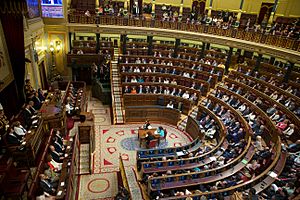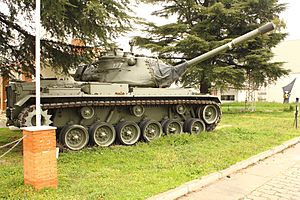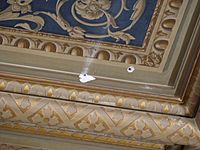1981 Spanish coup d'état attempt facts for kids
Quick facts for kids 1981 Spanish coup d'état attempt |
|||||||
|---|---|---|---|---|---|---|---|
| Part of the Spanish transition to democracy | |||||||
 Plenary Hall of the Congress of Deputies (lower house of the Spanish legislature), in Madrid, where a group of Civil Guards, led by Antonio Tejero, burst in violently. |
|||||||
|
|||||||
| Belligerents | |||||||
|
|
||||||
| Commanders and leaders | |||||||
|
|||||||
| Strength | |||||||
| All of the Spanish military and police corps except for the rebels | 1,800 men (in Valencia) 200 Civil Guards (in Madrid) Dozens of tanks and other military vehicles |
||||||
| Casualties and losses | |||||||
| None | |||||||
The 1981 Spanish coup d'état attempt (Spanish: Intento de Golpe de Estado de España de 1981), also known as 23-F or the Tejerazo, was a failed attempt by some military and police officers to take control of the government in Spain in February 1981. A coup d'état is when a group tries to illegally overthrow a government.
This event was the last serious try to bring back a dictatorship in Spain. It actually helped make Spain's democracy stronger. King Juan Carlos I played a very important part in stopping the coup. Because of his actions, the monarchy became even more respected.
The coup started on February 23, 1981. Lieutenant-Colonel Antonio Tejero and about 200 armed Civil Guard officers stormed the Congress of Deputies (Spain's parliament) in Madrid. This happened during a vote to approve Leopoldo Calvo-Sotelo as the new Prime Minister.
The officers held the lawmakers and government officials hostage for 18 hours. During this time, the King spoke on television. He told everyone that the coup was wrong and that the democratic government must continue. His speech greatly weakened the coup. The hostage-takers gave up the next morning, and everyone was freed. Another coup attempt in Valencia, led by Captain General Jaime Milans del Bosch, also failed. Tejero, Milans del Bosch, and General Alfonso Armada were later sent to prison.
Contents
Why the Coup Happened
The coup attempt was connected to Spain's journey towards democracy after a long dictatorship. Several things caused problems for the government at the time:
- Economic Troubles: Spain was facing a tough economy. Many people were out of work, and prices were rising fast.
- Regional Issues: It was hard to give more power to different regions of Spain.
- Increased Violence: A Basque terrorist group called ETA was causing more violence.
- Military Opposition: Some people in the Spanish military did not like the new democracy.
Signs of trouble in the army appeared in 1977. An admiral resigned because he disagreed with the legalization of the Communist Party. In 1978, an earlier military plot called Operation Galaxia was stopped. Its leader, Lieutenant-Colonel Antonio Tejero, was sent to prison for a short time.
The government faced a big crisis in 1980. The Prime Minister, Adolfo Suárez, was losing support even within his own party. He resigned on January 29, 1981. This created a lot of uncertainty.
In early February 1981, tensions grew even more. There were protests and debates in parliament. A new Prime Minister, Leopoldo Calvo Sotelo, was chosen. However, he failed to get enough votes to become Prime Minister on February 20. A new vote was planned for February 23. This was the day the plotters chose for their coup.
The main people involved in the coup plan were Tejero and General Jaime Milans del Bosch. General Alfonso Armada, who was close to King Juan Carlos I, also had a smaller role.
The Coup Begins

The events inside the parliament were filmed by TV cameras and recorded by radio stations. This meant the world could see and hear what was happening. People in Spain listened on their radios, which is why this night is sometimes called "the Night of Transistor Radios."
Storming the Parliament
At 6:00 PM, the vote for the new Prime Minister began in the Congress of Deputies. At 6:23 PM, Lieutenant-Colonel Antonio Tejero and 200 armed Civil Guard officers burst into the chamber. Tejero shouted, "Nobody move!" and ordered everyone to lie on the floor.
Most of the lawmakers dropped to the floor. But three people stayed standing:
- General Manuel Gutiérrez Mellado, the acting Minister of Defense.
- Adolfo Suárez, the outgoing Prime Minister.
- Santiago Carrillo, the leader of the Communist Party.
General Gutiérrez Mellado, as the highest-ranking military officer present, refused to obey. He confronted Tejero and told him to stand down. Adolfo Suárez also moved to join Gutiérrez Mellado. There was a brief struggle, and Tejero fired a shot into the air. Other officers also fired their submachine guns. Despite the shots, 68-year-old General Gutiérrez Mellado bravely refused to sit down.
After a few minutes, all the lawmakers returned to their seats. A Civil Guard captain announced that everyone should wait for "the competent military authority."
Later, Prime Minister Suárez tried to speak to the commanders. More shots were fired, and a guard pointed a gun at the lawmakers. Suárez was forcefully taken to another room. When he asked Tejero to explain "this madness," Tejero only replied, "Everything for Spain!"
Five important lawmakers were separated from the others: Prime Minister Suárez, opposition leader Felipe González, his deputy Alfonso Guerra González, Communist Party leader Santiago Carrillo, and Defense Minister Agustín Rodríguez Sahagún. The rebels hoped that by taking these leaders, they could create a power vacuum and force a new government.
Military Action in Valencia
At the same time, General Jaime Milans del Bosch started his part of the coup in Valencia. He sent 2,000 soldiers and fifty tanks into the streets. They took over the city hall and other important buildings. Milans del Bosch declared a state of emergency, hoping other military leaders would join him.
However, his plan faced a problem. He sent tanks to the Manises Air Base to get its commander to support the coup. But the Colonel in charge refused. He even threatened to use fighter jets with missiles against the tanks. This forced Milans del Bosch to pull his tanks back. This setback showed that the coup was starting to fail.
King Juan Carlos Acts
King Juan Carlos I refused to support the coup. After talking with his military leaders, he was sure they were loyal to him and to Spain's Constitution. Around 1:14 AM on February 24, the King appeared on national television. He wore his military uniform, the highest rank in the Spanish Armed Forces. He spoke against the coup and its leaders, defending the Spanish Constitution. He also publicly rejected Milans del Bosch's actions.
From that moment on, it was clear the coup had failed. Milans del Bosch, now isolated, gave up his plans at 5:00 AM and was arrested. Many Civil Guards tried to escape from the parliament building, but they were arrested by officers who had surrounded the building. The lawmakers were freed that morning, shouting "Long Live Freedom!" Tejero resisted until midday on February 24 but was finally arrested outside the Congress building.
The events of the coup were later made into a movie called 23F.
What Happened Next
The most important result of the failed coup was that the monarchy became much stronger and more respected by the public and politicians. In the long run, the coup's failure was the last serious attempt by those who supported the old dictatorship to gain power in Spain.
The main leaders of the coup, Miláns del Bosch, Alfonso Armada, and Antonio Tejero Molina, were sentenced to thirty years in prison. In total, about thirty people were convicted for their part in the coup.
The bullet holes in the ceiling of the Spanish parliament were kept as a reminder of the coup attempt.
Other Ideas About the Coup
Because the coup ended without much bloodshed and some questions remained unanswered, some people have developed other theories about what really happened.
These theories suggest that the coup might have been partly planned by the Spanish Secret Services, along with the King and other political leaders. The idea was to create a "soft" coup. This "soft" coup would have replaced the elected government with a new "government of salvation" led by General Armada. This new government would have included ministers from all major political parties.
One goal of this "soft" coup was to remove Prime Minister Adolfo Suárez, who was facing a lot of criticism. Another goal was to push Spain towards joining NATO and the European Economic Community (now the European Union). It was also meant to get rid of the most extreme parts of the military and make ordinary people accept the monarchy and the two-party system.
Some theories even suggest that this "soft" coup was meant to stop a more dangerous "hard" coup that was planned for later that year.
According to these theories, Prime Minister Suárez knew about the "soft" coup plan. He resigned to try and stop it. However, the plan went ahead anyway. Tejero, who believed he was part of a "hardcore" coup, didn't understand the bigger picture. His violent actions and refusal to accept Armada's multi-party government led to both the "hard" and "soft" coup plans failing.
These alternative theories have been discussed over the years, but they are not widely accepted as the official story.
See also
 In Spanish: Golpe de Estado en España de 1981 para niños
In Spanish: Golpe de Estado en España de 1981 para niños
- 1982 Spanish coup d'état attempt
- Operación Galaxia, an earlier coup plan
Sources
- This article draws heavily on the corresponding article in the Spanish-language Wikipedia, which was accessed in the version of 29 January 2006.


